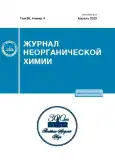DFT Modeling of Isomerism of Doped Mg24L2 Clusters with Dopants L at the Surface and inside the Magnesium Cage
- Авторлар: Charkin O.P.1
-
Мекемелер:
- Federal Research Center of Problems of Chemical Physics and Medicinal Chemistry, Russian Academy of Sciences
- Шығарылым: Том 68, № 4 (2023)
- Беттер: 499-508
- Бөлім: ТЕОРЕТИЧЕСКАЯ НЕОРГАНИЧЕСКАЯ ХИМИЯ
- URL: https://journals.rcsi.science/0044-457X/article/view/136325
- DOI: https://doi.org/10.31857/S0044457X23700186
- EDN: https://elibrary.ru/FNKERX
- ID: 136325
Дәйексөз келтіру
Толық мәтін
Аннотация
The isomers of Mg24L2 nanoclusters with dopants L from the firt three periods (L = Li–Zn) in the exo- and endohedral positions of the magnesium cage have been calculated by the density functional theory (DFT) method. The effect of dopants on the structure, stability, and position on the energy scale has been studied. For the systems with atoms L = H, Li, Be N, Na, Co, and Cu, the “open” positions of dopants at the surface are more favorable, unlike their analogs with L = Be and B, for which the “closed” positions in the inner cavity of the cluster are more favorable and their promotion to the surface requires a significant energy input. For clusters with O, Si, P, S, and early 3d metal atoms, the differences in the energies of the exo- and endohedral isomers do not exceed a few kcal/mol. The atoms of the second half of the 3d series are characterized by their association into diatomic dopants L2. The results are compared with the data of similar DFT calculations of isomers of Al42L2 aluminum clusters with the same dopants L = Li–Zn and are of interest for modeling the mechanisms of catalytic hydrogenation of magnesium and aluminum nanoclusters at the molecular level.
Негізгі сөздер
Авторлар туралы
O. Charkin
Federal Research Center of Problems of Chemical Physics and Medicinal Chemistry, Russian Academy of Sciences
Хат алмасуға жауапты Автор.
Email: rusjinorgchem@yandex.ru
142432, Chernogolovka, Moscow oblast, Russia
Әдебиет тізімі
- Kawazoe Y., Kondow T., Ohno K. Clusters and Nanomaterials. Berlin: Springer-Verlag, 2002. ISBN: 978-3-662-04812-2
- Rienstra-Kirakofe J.C., Schumper G.S., Shaefer H.F. et al. // Chem. Rev. 2002. V. 102. P. 231. https://doi.org/10.1021/cr990044u
- Kuznetsov A.E., Birch K.A., Boldyrev A.I. et al. // Science. 2003. V. 300. P. 622. https://doi.org/10.1126/science.1082477
- Charkin O.P., Klimenko N.M., Charkin D.O. et al. // Faraday Discuss. 2003. V. 124. P. 215. https://doi.org/10.1039/B211114D
- Janssens E., Neukermans S., Lievens P. // Curr. Opin. Solid State Mater. Sci. 2004. V. 8. P. 185. https://doi.org/10.1016/j.cossms.2004.09.002
- Bailey M.S., Wilson N.T., Roberts C. et al. // Eur. Phys. J. D. 2003. V. 25. P. 41. https://doi.org/10.1140/epjd/e2003-00218-2
- Brodova I.G., Shirinkina I.G., Petrova A.N. // Lett. Mat. 2011. V. 1. P. 32. https://doi.org/10.22226/2410-3535-2011-1-32-35
- Hua Y., Lin Y., Jang G. et al. // J. Phys. Chem. A. 2013. V. 117. P. 2590. https://doi.org/10.1021/jp309629y
- Ko Y.J., Shakya A., Wang H.P. et al. // J. Chem. Phys. 2010. V. 133. P. 124308. https://doi.org/10.1063/1.3490401
- Lang S.M., Claes P., Neukermans S. et al. // J. Am. Soc. Mass Spectrom. 2011. V. 22. P. 1508
- Jimmenes-Iszal E., Moreno D., Mercero J.M. et al. // J. Phys. Chem. A. 2014. V. 118. P. 4309. https://doi.org/10.1021/jp501496b
- Zheng M.M., Li S.J., Su Y. et al. // J. Phys. Chem. C. 2013. V. 117. P. 25077. https://doi.org/10.1021/jp4072839
- Costanzo E., van Hemert M.C., Kroes G.-J. // Phys. Chem. C. 2014. V. 118. P. 513. https://doi.org/10.1021/jp410482x
- Smith J.C., Reber A.C., Khana S.N. et al. // J. Phys. Chem. A. 2014. V. 118. P. 8485. https://doi.org/10.1021/jp501934t
- Das S., Pal S., Krishnamurty S. // J. Phys. Chem. C. 2014. V. 118. P. 19869. https://doi.org/10.1021/jp505700a
- Mikhailin A.A., Charkin O.P., Klimenko N.M. // Russ. J. Inorg. Chem. 2013. V. 58. P. 1439. https://doi.org/10.1134/S0036023613120073
- Zhu B.-C., Zhang S., Zeng L. // Int. J. Quant. Chem. 2020. V. 120. P. 26143. https://doi.org/10.1002/qua.26143
- He C., Chen Y., Sheng Y. // Eur. Phys. J. D. 2019. V. 73. P. 90. https://doi.org/10.1140/epjd/e2019-90521-6
- Kumar A., Vyas N., Ojna A.K. // Int. J. Hydrogen Energy. 2020. V. 45. P. 12961. https://doi.org/10.1016/j.ijhydene.2020.03.018
- Zeng L., Liang M.-K., Wei X.-F. et al. // J. Phys. Condens. Matter. 2021. V. 33. P. 065302. https://doi.org/10.1088/1361-648X/abc401
- Mal’tsev A.P., Charkin O.P. // Russ. J. Inorg. Chem. 2021. V. 66. P. 1860. https://doi.org/10.1134/S0036023621120111
- Charkin O.P., Mal’tsev A.P. // J. Phys. Chem. A. 2021. V. 125. P. 2308. https://doi.org/10.1021/acs.jpca.1c00211
- Charkin O.P., Klimenmo N.M. // Russ. J. Inorg. Chem. 2018. V. 63. P. 1578. https://doi.org/10.1134/S0036023618120069
- Frisch M.J., Trucks G.W., Schlegel H.B. et al. GAUSSIAN-09, Revision A.02 (Gaussian, Inc., Wallingdorf CT, 2013).
- Becke A.D.J. // J. Chem. Phys. 1993. V. 98. P. 5648. https://doi.org/10.1063/1.464913
- Lee C., Yang W., Parr R.G. // Phys. Rev. B. 1998. V. 37. P. 785. https://doi.org/10.1103/PhysRevB.37.785
- Zou Q., Akoda Y., Yamamoto K. et al. // Angew. Chem. Int. Ed. 2022. V. 61. P. e202209679. https://doi.org/10.1002/anie.202209675











